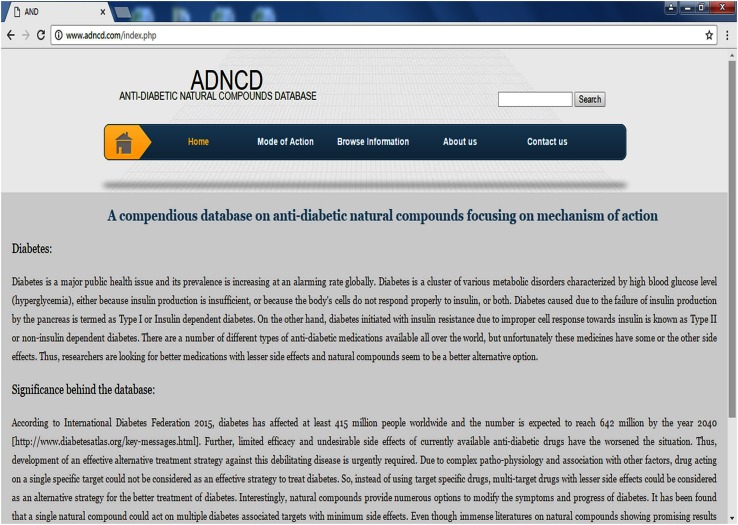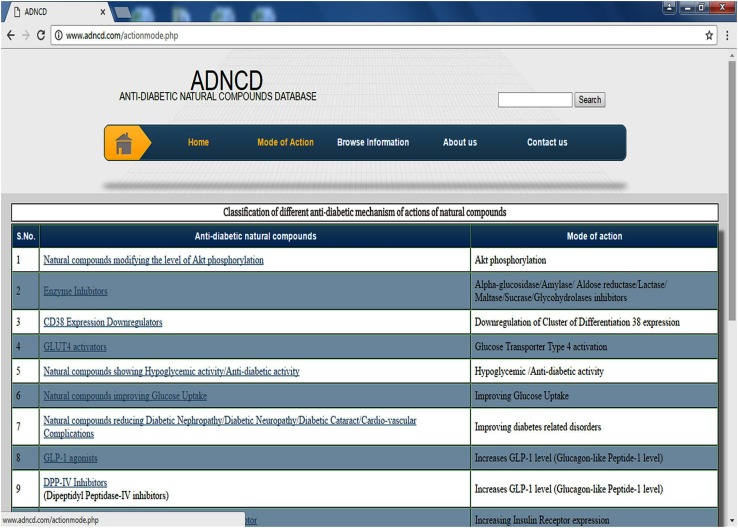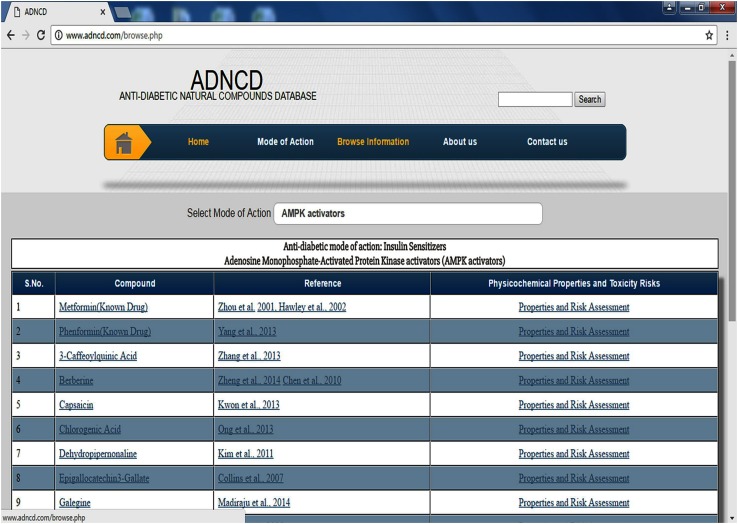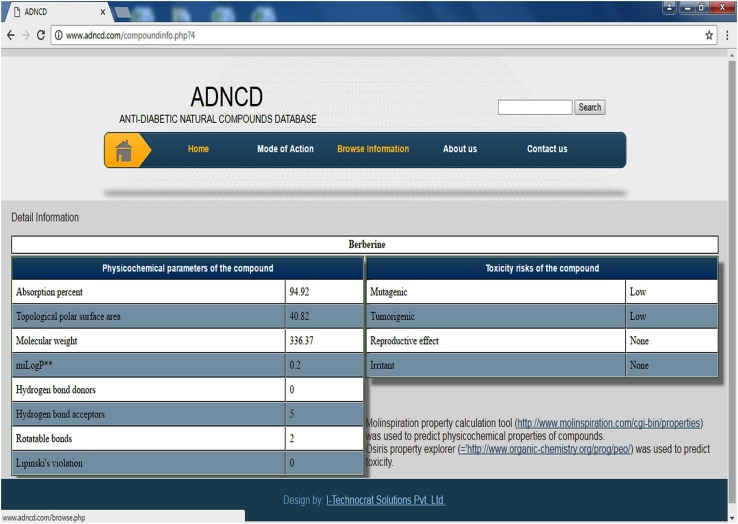Abstract
Diabetes is a deteriorating metabolic ailment which negatively affects different organs; however, its prime target is insulin secreting pancreatic β-cells. Although, different medications have been affirmed for diabetes management and numerous drugs are undergoing clinical trials, no significant breakthrough has yet been achieved. Available drugs either show some side effects or provide only short-term alleviation. The rationales behind the failure of current anti-diabetic treatment strategy are association of complex patho-physiologies and participation of various organs. Consequently, there is a critical need to search for multi-effect drugs that might impede various patho-physiological mechanisms related to diabetes. Fortunately, one natural compound could act on several diabetes linked targets. Thus, natural compounds might be regarded as a viable alternative choice to improve the progression as well as side effects of diabetes. Despite the fact that immense literatures are available on natural compounds indicating promising outcomes against diabetes, more systematic studies are still needed to establish them as effective anti-diabetic agents. Till date, we are unable to access all the information regarding modes of action, toxicity risks and physicochemical properties of anti-diabetic natural compounds on one platform. Hence, anti-diabetic natural compounds database (ADNCD) has been created to categorize each anti-diabetic natural compound on the basis of their mode of action and to provide compendious information of their physicochemical properties and toxicity risks. In short, ADNCD has imperative information for the researchers working in the field of diabetes drug development.
Keywords: Diabetes, Anti-diabetic drugs, Pancreatic β-cells, Anti-diabetic natural compounds, Hyperglycaemia
Introduction
Diabetes mellitus is a multifarious metabolic sickness that is associated with tenacious hyperglycemia (Malviya et al. 2010; Alqahtani et al. 2013; d’Emden et al. 2015; Hameed et al. 2015; Diabetes Canada Clinical Practice Guidelines Expert Committee et al. 2018). According to IDF: International Diabetes Federation (2015) report, approximately 415 million individuals were suffering from diabetes all over the world and the figure is expected to reach 642 million by the year 2040 (International Diabetes Federation 2015). Among different types of diabetes, Type II diabetes is a major class which accounts for over 90% of diabetic cases (Olokoba et al. 2012; Maitra and Abbas 2005; Chang et al. 2013). There are various distinctive sorts of anti-diabetic medications available globally, however, the vast majority of these medications failed due to limited efficacy and undesirable side effects. It is very unfortunate that at an interval of every six seconds an individual dies due to diabetes and about 5 million people have died because of it in the year 2015 (International Diabetes Federation 2015). Thus, the establishment of other viable strategy to tackle this deteriorating disease is essentially required. The main obstructions regarding diabetes treatment are its complex patho-physiology and association of several factors. Therefore, rather than applying single target-specific drugs, multi-target drugs appear to be a valuable and compelling approach for the management of diabetes. Interestingly, some natural compounds have demonstrated encouraging outcome against diabetes (Malviya et al. 2010; Ota and Ulrih 2017; Zeidan et al. 2017; Choudhury et al. 2017; Governa et al. 2018), while, new remedies based on natural compounds are still in great demand because of their easy availability and inexpensiveness. It is a riveting fact that a single natural compound could act on different diabetic patho-physiologies at once with minimum side effects. Consequently, natural compounds might be mulled over as the most practical choices for diabetes management or fortification of currently used treatments. An abundance of research articles on natural compounds possessing anti-diabetic potential are already available, however, research and clinical trials are currently going on to establish these compounds as future therapeutic products for diabetes.
Some outcomes obtained from these studies were extremely encouraging, but still we are unable to find out a breakthrough medicine from these anti-diabetic natural compounds. Hence, we require an increasing number of systematic studies along with the exact classification of natural compounds based on their anti-diabetic mode of action. To the best of the author’s knowledge, at present, none of the accessible databases provide data on anti-diabetic natural compounds with respect to their mode of action. Therefore, a compendious database, i.e., anti-diabetic natural compound database (ADNCD) was designed to pile up the information categorizing anti-diabetic natural compounds based on their different mechanisms of action which includes various enzymes, proteins, genes, channels, receptors, pathways and other important aspects at one platform. In addition, ADNCD would also offer an option to observe the toxicity and physicochemical properties of each and every anti-diabetic natural compound available in the database. We firmly believe that ADNCD would provide valuable information to the scientists, herbal drug manufacturing industries and clinicians who are struggling to find out a strong alternative against diabetes.
Methodology
Database architecture and tools
Anti-diabetic natural compounds database was arranged on apache server. However, to offer vivacity on the web interface, hypertext preprocessor program (PHP) along with JavaScript and HTML were used. Database information in tabulated form was stored in MySQL (Structured Query Language) 5.0 which is a relational database at the backend and this tool also helps in retrieving data with flexibility and speed. For the users, the database consists three main options, i.e., Home, Mode of Action and Browse information for retrieving useful scientific data on anti-diabetic natural compounds. In addition, the users have an option of direct searching for any anti-diabetic mode of action. Interestingly, under every mode of action each compound is linked to the PubChem compound database, cross references and provides information on physicochemical properties and toxicity risks. Two more options, i.e., About us and Contact us are also available for obtaining information about author’s current research areas, research team and contact address.
The database access
ADNCD database has five options along with one search option for the users. The first option is Home which provides basic information regarding diabetes and significance of ADNCD database (Fig. 1). The second option is Mode of Action that contains a table presenting a classification of different anti-diabetic mechanism of actions of natural compounds (Fig. 2). Here, the user could click on each mechanism of action and browse it directly or user could opt for the third option, i.e., Browse Information (Fig. 3). In Browse Information, the user could select the mode of action in the drop-down search box and retrieve information regarding each natural compound coming under the selected mode of action. At this juncture, user could get structural information about each natural compound from PubChem database, retrieve the literature from the linked cross reference and gather information regarding physicochemical properties and toxicity risks (Fig. 4) in a click.
Fig. 1.
Home page describing the significance of the database
(ADNCD screen capture http://www.adncd.com/index.php)
Fig. 2.
Mode of action page classifying different anti-diabetic mode of actions of natural compounds (ADNCD screen capture http://www.adncd.com/actionmode.php)
Fig. 3.
Browse information page with drop-down box for selecting anti-diabetic mode of action and helps in browsing information linked to natural compounds under each mode of action
(ADNCD screen capture http://www.adncd.com/browse.php)
Fig. 4.
Information about physicochemical properties and toxicity risks of each anti-diabetic natural compound.
(ADNCD screen capture http://www.adncd.com/compoundinfo.php?4)
Data collection
All the sources used for gathering and compiling of data in ADNCD were authentic such as PubChem and Pubmed. For the calculation of physicochemical properties and toxicity risks of each compound, Molinspiration property calculation and Osiris property explorer online tools were used.
Web-Link for accessing ADNCD: anti-diabetic natural compounds database
Discussion and future prospects
Anti-diabetic natural compounds database (ADNCD) is the first compendious database which categorizes different natural compounds based on their anti-diabetic mode of actions. In addition, it provides essential data with respect to the physicochemical properties and toxicity risks of these anti-diabetic natural compounds. Few known drugs against some anti-diabetic mode of actions are also included in the database, as a reference to compare with natural compounds.
This database would assist the researchers by limiting their endeavors to gather the information from various different resources. Here, the majority of the information would be accessible in a single click. As several researches are still going on and information is evolving day-by-day, we would bit by bit refresh the database and include new most recent informations once they become available. However, our future plan is to add information regarding structure-based anti-diabetic activity of natural compounds.
Acknowledgements
Aisha Khatoon is supported by Maulana Azad National Fellowship grant from UGC, New Delhi, India (Grant number: MANF-2014-15-MUS-UTT-36526). Sibhghatulla Shaikh is supported by INSPIRE grant from the Department of Science & Technology (DST), New Delhi, India (Grant number: IF130056), which is sincerely acknowledged. We would like to thank the developers of Mol inspiration property calculation tool and Osiris property explorer.
Compliance with ethical standards
Conflict of interest
On behalf of all authors, the corresponding author states that there is no conflict of interest.
References
- Alqahtani N, Khan WA, Alhumaidi MH, Ahmed YA. Use of glycated hemoglobin in the diagnosis of diabetes mellitus and pre-diabetes and role of fasting plasma glucose, oral glucose tolerance test. Int J Prev Med. 2013;4:1025–1029. [PMC free article] [PubMed] [Google Scholar]
- Chang CL, Lin Y, Bartolome AP, Chen YC, Chiu SC, Yang WC. Herbal therapies for type 2 diabetes mellitus: chemistry, biology, and potential application of selected plants and compounds. Evid Based Complement Alternat Med. 2013;2013:378657. doi: 10.1155/2013/378657. [DOI] [PMC free article] [PubMed] [Google Scholar]
- Choudhury H, Pandey M, Hua CK, Mun CS, Jing JK, Kong L, Ern LY, Ashraf NA, Kit SW, Yee TS, Pichika MR, Gorain B, Kesharwani P. An update on natural compounds in the remedy of diabetes mellitus: a systematic review. J Tradit Complement Med. 2017;8:361–376. doi: 10.1016/j.jtcme.2017.08.012. [DOI] [PMC free article] [PubMed] [Google Scholar]
- d’Emden MC, Shaw JE, Jones GR, Cheung NW. Guidance concerning the use of glycated haemoglobin (HbA1c) for the diagnosis of diabetes mellitus. Med J Aust. 2015;203:89–90. doi: 10.5694/mja15.00041. [DOI] [PubMed] [Google Scholar]
- Diabetes Canada Clinical Practice Guidelines Expert Committee. Punthakee Z, Goldenberg R, Katz P. Definition, classification and diagnosis of diabetes, prediabetes and metabolic syndrome. Can J Diab. 2018;42:S10–S15. doi: 10.1016/j.jcjd.2017.10.003. [DOI] [PubMed] [Google Scholar]
- Governa P, Baini G, Borgonetti V, Cettolin G, Giachetti D, Magnano AR, Miraldi E, Biagi M. Phytotherapy in the management of diabetes: a review. Molecules. 2018;23:E105. doi: 10.3390/molecules23010105. [DOI] [PMC free article] [PubMed] [Google Scholar]
- Hameed I, Masoodi SR, Mir SA, Nabi M, Ghazanfar K, Ganai BA. Type 2 diabetes mellitus: from a metabolic disorder to an inflammatory condition. World J Diab. 2015;6:598–612. doi: 10.4239/wjd.v6.i4.598. [DOI] [PMC free article] [PubMed] [Google Scholar]
- International Diabetes Federation (2015) http://www.diabetesatlas.org/key-messages.html. Accessed 21 Jan 2017
- Maitra A, Abbas AK. Endocrine system. In: Kumar V, Fausto N, Abbas AK, editors. Robbins and cotran pathologic basis of disease. 7. Philadelphia: Saunders; 2005. pp. 1156–1226. [Google Scholar]
- Malviya N, Jain S, Malviya S. Antidiabetic potential of medicinal plants. Acta Pol Pharm. 2010;67:113–118. [PubMed] [Google Scholar]
- Olokoba AB, Obateru OA, Olokoba LB. Type 2 diabetes mellitus: a review of current trends. Oman Med J. 2012;27:269–273. doi: 10.5001/omj.2012.68. [DOI] [PMC free article] [PubMed] [Google Scholar]
- Ota A, Ulrih NP. An overview of herbal products and secondary metabolites used for management of type two diabetes. Front Pharmacol. 2017;8:436. doi: 10.3389/fphar.2017.00436. [DOI] [PMC free article] [PubMed] [Google Scholar]
- Zeidan M, Rayan M, Zeidan N, Falah M, Rayan A. Indexing natural products for their potential anti-diabetic activity: filtering and mapping discriminative physicochemical properties. Molecules. 2017;22:E1563. doi: 10.3390/molecules22091563. [DOI] [PMC free article] [PubMed] [Google Scholar]






